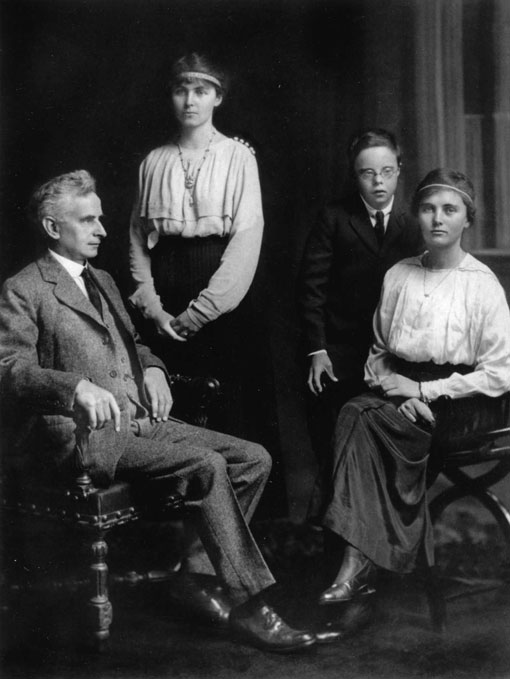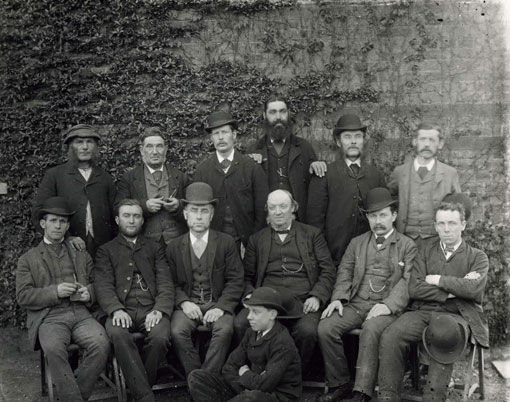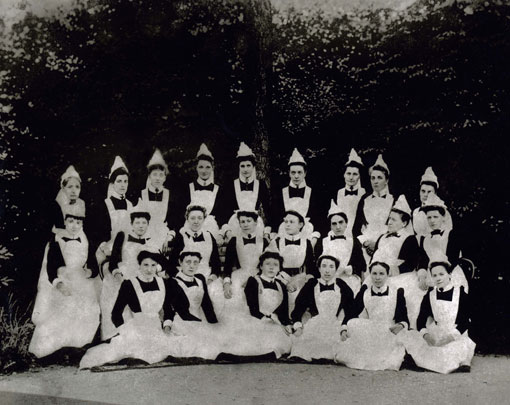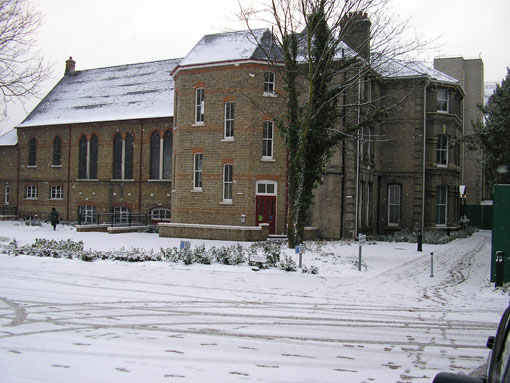Written by Stella Brain nee Langdon Down
John Haydon Langdon-Down was born in 1828. After qualifying as a doctor at the London Hospital he became Physician Superintendent at the Royal Earlswood Hospital in 1858. Ten years later he opened a private home for subnormal patients at Normansfield, Teddington. Throughout his active medical career he practised as a consulting physician and continued his research in that special condition he called Mongolism, later to be designated Down’s syndrome.
Normansfield started with about 20 patients in a family house, standing in a park, which had been built two years and never occupied. A home such as this near London supplied a need and with the help of business friends, relatives, and well-wishers he raised the capital to develop and purchase two adjoining properties. New wings were added to the original house on either side, a recreation and entertainment Hall was built, also artisan workshops, a men’s club and a laundry, so that the growing hospital was self-sufficient.
Between 1868 and 1891 it had expanded to accommodate 150 patients with provision for resident staff. His wife Mary, a very able and practical woman, assisted him in the management of the hospital and was to a great extent responsible for the engagement of staff and the day-to-day organisation, while her husband continued his consulting practice and his lectures at the London Hospital to students and practitioners. Normansfield became very well known and there were constant requests for placing patients.
When John Haydon Langdon-Down died in 1896 and his widow in 1901 they left Normansfield free of debt, all the mortgages paid off, a happy and flourishing home for those unfortunate people they had cared for all their married life.


Reginald and Percy, their two sons, who were both medically qualified had already assisted their parents and took on the responsibility of the hospital.
Reginald, who married a Nursing Sister at the London hospital took on his father’s work, carrying on a consulting practice. He and his wife took up residence at Normansfield in the main centre, the original house. His wife became concerned with the day-to-day organisation. He continued the lectures to students and also wrote articles on Down’s syndrome.
Percival took over the responsibility for the day-to-day medical care of patients and staff and for the management of the estate. He was very interested in amateur theatricals and a local club founded by the family continued to use the entertainment hall at Normansfield until the First World War.
During the years from the beginning of this century up to the First World War the hospital advanced under the direction of the brothers. Medical care, training and occupation of the patients progressed as learning and understanding of these patients advanced. The hospital divided into four parts, one wing for women and children, another for men and boys and two houses, one for higher-grade women and the other for higher-grade men. Each of these groups had its own part of the garden and parkland. Patients took daily exercise and games were organised. Handicrafts, and what would now be called occupational therapy, were a great feature.
Kindergarten with several teachers provided the education; dancing lessons and roller- skating were also regular events. Entertainments provided by the staff under the direction of Mr. Buchanan and Mr. Cowburn were greatly looked forward to; patients sometimes took part and the programme was printed in the Normansfield press.
Church services were held every Sunday in the Hall and groups of patients and staff joined in choir practice. At Christmas there was a Christmas tree, entertainment and Christmas dinner followed by dancing.
The other great excitement was the annual visit to the seaside. A school on the South Coast was rented for six weeks during the school holidays and almost all the patients had a holiday. In the early days a special train conveyed the household with bedding, linen, crockery and many trunks of clothing. Later the household went by coaches. This was an annual event up to the Second World War.
Normansfield had a flourishing farm and garden. The well known herd of large black and middle white pigs took many prizes. Cows and chickens and a productive kitchen garden provided home-grown produce for the kitchens and gave occupation to the patients.



When Normansfield first opened staff were drawn from the villages around and several local families, notably the Smiths, the Mills and the Morrises served the hospital for many years. Jim Smith and Miss Cheek MacKinnon completing 50 years service each. The records of long service hang in the Hall and in these one finds the names of people from all departments of the hospital – Nursing, Domestics, Artisans, Garden and Laundry.
The First World War was a time of great trial. Reginald’s wife died in 1917 and Percival’s wife took over her place in the day-to-day management. After the war things gradually returned to routine, with inevitable changes, but in many respects following on the activities of the past. Expenses mounted and fees had to be increased as the cost of wages and maintenance rose.
In 1922 Reginald married Miss Turnbull whom he met at Hildenborough in connection with the Princess Christian Farm Colony for mentally subnormal men.
Percival died in 1925 and for a quarter of a century the brothers had carried on the work of their parents. The families of the two brothers had by now grown up.
With the outbreak of the Second World War the problems of keeping a private hospital were immense and in 1940 Stella Brain was asked to help and she and her family returned to Teddington to help Reginald and Mrs.Percy who were both over 70. The hospital’s proximity to the National Physical Laboratory in Teddington, Teddington-Lock and Richmond Park, where fire burned to induce enemy planes to think they were over London, meant the hospital was in a danger area and had to prepare for emergencies. A V1 and 24 high explosive bombs and many incendiaries dropped on the 38 acre estate but most fortunately without a single casualty.
In preparation, air raid shelters had been built but these proved unsuitable and the patients were moved to dormitories in the semi-basements on both North and South wings. Bunks were put up and beds filled the basement passages. Praise for the staff cannot be high enough – the morale was excellent. Everybody took the situation as a matter of course and it is only on looking back that one is amazed at the courage and endurance of all staff. The artisans and ground staff took on rotas of alert service and fire watching.
The routine of the hospital was maintained but the problems of continuing a private establishment after the war were overwhelming and so, with the advent of the National Health Service, negotiations took place to sell the hospital to the Government. The safeguarding of the continued care of the patients, and the future of the staff employed in the hospital were the first consideration of the Management. The transfer came about very smoothly and few, if any, suffered. Some patients were moved elsewhere, some staff retired but the hospital continued with a member of the family, Dr. Norman Langdon-Down, as Physician Superintendent and the Staines Group Hospital Management Committee became the responsible authority.
Reginald Langdon-Down died in 1955. He would have been very proud that the family had provided Physician Superintendents of Normansfield in unbroken succession for the whole 100 years.



